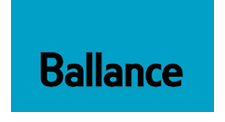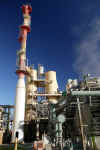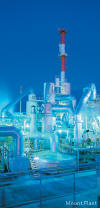|
||
| Sulphuric Acid on the WebTM | Technical Manual | DKL Engineering, Inc. |
Knowledge for the
Sulphuric Acid Industry
![]()
Sulphuric Acid on the Web
Introduction
General
Equipment Suppliers
Contractor
Instrumentation
Industry News
Maintenance
Acid
Traders
Organizations
Fabricators
Conferences
Used
Plants
Intellectual
Propoerty
Acid
Plant Database
Market
Information
Library
Technical Manual
Introduction
General
Definitions
Instrumentation
Plant Safety
Metallurgial
Processes
Metallurgical
Sulphur Burning
Acid Regeneration
Lead Chamber
Technology
Gas Cleaning
Contact
Strong Acid
Acid Storage
Loading/Unloading
Transportation
Sulphur
Systems
Liquid SO2
Boiler Feed Water
Steam Systems
Cooling Water
Effluent Treatment
Utilities
Construction
Maintenance
Inspection
Analytical Procedures
Materials of Construction
Corrosion
Properties
Vendor Data
DKL Engineering, Inc.
Handbook of Sulphuric Acid Manufacturing
Order
Form
Preface
Contents
Feedback
Sulphuric Acid
Decolourization
Order Form
Preface
Table of Contents
Process Engineering Data Sheets - PEDS
Order
Form
Table of Contents
Introduction
Bibliography of Sulphuric Acid Technology
Order Form
Preface
Contents
Acid Plant Database April 16, 2025
| Owner | Ballance Agri-Nutrients Co-operative Limited |   |
| Location |
Hewlett's Road Mount Maunganui New Zealand |
|
| Background |
Formerly - Bay of Plenty Fertilizer Ltd. The Co-operative has an 80% shareholding in Ballance Agri-Nutrients with the remaining 20% controlled by Norsk Hydro |
|
| Website | www.ballance.co.nz | |
| Plant | - | |
| Coordinates* | 37º 40' 2" S, 176º 10' 52" E | |
| Type of Plant | Sulphur Burning | |
| Gas Source | Elemental Sulphur | |
| Plant Capacity | 480 MTPD | |
| SA/DA | - | |
| Status |
Operating Shutdown November 2025 |
|
| Year Built | - | |
| Technology | - | |
| Contractor | - | |
| Remarks |
In 2017 Page Macrae Engineering was contracted by
Ballance Agri-Nutrients to replace the sulphuric acid converter and pipework
at their Mount Maunganui site. The 18,000 hour project involved the
demolition and removal of the existing converter vessel and site
installation of the new converter, plus fabrication and installation of new
pipework, platforms and handrails. These were fabricated off-site at Page
Macrae Engineering’s workshops in Mount Maunganui then transported to site.
Demolition of the old converter vessel brought its challenges as its general
condition was unknown. Despite this, the Page Macrae Engineering team had it
demolished and removed two days ahead of schedule. The new converter was
lifted into place using New Zealand’s second largest crane with 160 tonnes
of counterweight. The project involved collaboration with several
teams including scaffolders, insulators and other contractors all who all
worked within the confined area.
|
|
| Pictures |   
 |
|
| General |
Ballance Agri-Nutrients Limited is one of New Zealand’s leading fertiliser
specialists, with manufacturing plants located in Whangarei, Mount Maunganui
and Invercargill. In addition, the company owns the ammonia-urea
manufacturing plant at Kapuni in Taranaki, and Super Air, one of the
country’s largest agricultural aviation companies. Ballance is a 100-percent farmer-owned co-operative, with some 18,000 shareholders throughout New Zealand. It was officially launched in 2001, the final step in a series of company amalgamations and alliances that saw regional fertiliser co-operatives come together under the umbrella of what was then Bay of Plenty Fertiliser. Today, Ballance is a truly national company, with staff located from the Far North to the Deep South. The company places a strong emphasis on delivering value to its shareholders and on the use of a scientific approach to plant nutrient management At the heart of the operation is head office, located in Mount Maunganui. As well as being the home of key corporate staff, the Mount site incorporates the company’s largest fertiliser manufacturing facility. The close proximity to the Port of Tauranga means that imported raw materials and high-analysis fertilisers are easily transported to the works site, where a range of products, including superten, the company’s flagship fertiliser, are produced. |
|
| References | - | |
| News |
November 24,
2025 - Ballance Agri-Nutrients’ decision to end its Mount Maunganui
manufacturing operations is an opportunity to reconsider other heavy
industries in the area, a marae representative says. Ballance chief
executive Kelvin Wickham says the winding down of manufacturing operations
at the Hewletts Rd/State Highway 2 site was “nearly complete” and the
final single super phosphate production had already taken place. “Our
final sulphuric acid production will occur this month,” Wickham said.
The farmer-owned fertiliser and nutrients cooperative is transforming the
site into a storage and distribution centre, resulting in 60 jobs being cut
and six new roles being created. The Ballance site neighbours Whareroa
Marae, and the marae’s residential community on Taiaho Place.The harbourside
marae, built in 1873, is surrounded by Mount Maunganui’s industrial zone,
centred on the Port of Tauranga.Whareroa environmental spokesman Joel
Ngātuere said the marae community welcomed Ballance’s decision.Ngātuere
acknowledged the “difficulties and stresses” faced by affected Ballance
staff and their families.“Some of these are our family and friends, so we
understand the stress this has created for a number of people.”However,
Ngātuere said Ballance and other heavy industry operators in the Mount
Maunganui airshed should “never have been allowed to be positioned on our
doorstep” in the first place.He said this was a “failure of successive
councils” and city and regional council leadership.“We have been working
with the [Ballance] chief executive and the chair, who have been keeping us
informed of the future direction and some of the strategic positioning of
their business.”The Mount Maunganui industrial zone was declared a polluted
airshed in 2019.“Everybody is fully aware of the longstanding
intergenerational harm caused to our community, especially, from air
pollution,” Ngātuere said.A 2023 Toi Te Ora Public Health study found Mount
Maunganui’s poor air quality contributed to an estimated 13 extra premature
deaths each year.At a public meeting in Mount Maunganui last year, Toi Te
Ora Public Health medical officer of health Dr Jim Miller said poor air
quality was a “much bigger health issue” than people realised.He said the
long-term effects included increased risk of strokes, lung cancer and
cardiovascular issues.Ngātuere said, in his view, heavy industry had
contributed to the air pollution.In his opinion, “Ballance and other heavy
industry businesses have all contributed to the worsening of the Mount
Maunganui peninsula’s polluted industrial airshed.”He said Ballance’s
decision was an “ideal opportunity’ for other heavy industry operators in
the peninsula to investigate options for how they might relocate to a
”fit-for-purpose" industrial zone, such as the new Rangiuru Business
Park.“In doing so, they could increase their productivity, increase jobs and
investment in the region, while still maintaining a close relationship with
the Port of Tauranga.”He said this was not about trying to shut down heavy
industry businesses in Mount Maunganui. “It’s about ensuring they are located in the right areas and ensuring those who live, work and play in the Mount Maunganui peninsula can enjoy clear air and not be poisoned from chronic exposure.”In 2018 the Bay of Plenty Times reported Ballance Agri-Nutrients had spent $8.5 million to improve air quality around its Mount Maunganui fertiliser works, including a better quality of life for the Whareroa Marae community.The clean-up was among initiatives to crack down on airborne pollutants in the port and Mount industrial area including dust, sulphur dioxide, hydrogen sulphide and the toxic gas used to fumigate log stacks - methyl bromide.Complaints about air quality generated from the port and Mount industrial area had soared in previous years.In response to Ngatuere’s comments, Wickham said Ballance held a consent to discharge to air from the site.This included discharges from its fertiliser and sulphuric acid manufacturing plants. “As a result of ceasing manufacture, the chimney stacks will be removed over time.”He said more details about the decommissioning of the manufacturing operations would be revealed at a later date.Since deciding to cease manufacturing in Mount Maunganui, he said the company had been supporting team members impacted by the decision.This had included career and job-seeking support and a range of information sessions.He said that the new roles created – a technical engineering manager, a maintenance supervisor and four site services technicians – were filled by employees whose prior jobs were disestablished.Five additional staff had been redeployed elsewhere in the business, and some were staying on temporarily to support the site transition and decommissioning work.
Ballance proposal to cut 62 jobs: Workers feel 'blindsided'... ‘Ticking time bomb’: Family speak out on factory worker’s ... Coroner rejects call for further inquiry into conveyor belt system 60 jobs gone: Ballance boss tells of 'very difficult' ...
April 16, 2025 - Ballance Agri-Nutrients is proposing to stop its manufacturing operations in Mount Maunganui and turn the site into a storage and distribution centre. In a statement today, the company said it was consulting with staff on ceasing the manufacturing of sulphuric acid and single super phosphate at its Hewletts Rd site. This would impact some specific roles associated with acid and phosphate manufacture. Sixty-eight roles would be disestablished and six new roles created, resulting in a net reduction of 62 roles, the statement said. The nationwide farmer and grower co-operative intended to use the facility, which had direct access to the Port of Tauranga, for nutrient storage and distribution, and for its national support office. Under the proposal, the co-operative would continue manufacturing phosphate in Invercargill and urea in Taranaki. Ballance chief executive Kelvin Wickham said the proposal was part of a wider process the organisation had undertaken in the past year to get ahead of sector changes and identify future opportunities to support New Zealand farmers and growers. “In the coming years, we expect to see an increased range of products and services that more efficiently and effectively deliver essential nutrients for farmers and growers, which will result in reduced overall demand for single super phosphate from historical peak volumes,” he said. “The number of existing facilities currently making this product in New Zealand means there is an overcapacity of supply.” Wickham said the Mount Maunganui facilities needed substantial investment to keep them operating reliably and would face increasing regulatory constraints to continue operating heavy manufacturing. Consultation with Ballance people was the “immediate priority”, Wickham said, and was anticipated to take four to six weeks. “At the end of the consultation period, we’ll take time to consider all feedback before we make a final decision and let everyone know where things have landed and what our next steps are,” he said. The change would enable more “agility” in nutrient sourcing, and new ways to provide value to shareholders, exploring more blended fertilisers and other products being utilised from the Mount Maunganui site, Wickham said. “Manufacturing remains an important part of how we supply New Zealand’s farmers and growers with reliable, secure and affordable access to nutrients. “Keeping a presence in Mount Maunganui as a strategic location for nutrient supply through the Port of Tauranga and our home base for our national support office is also a priority,” he said. July 16, 2018 - Ballance Agri-Nutrients has been fined $82,500 for the unauthorised discharge of contaminants, namely sulphur dioxide, from its fertiliser manufacturing plant in Mount Maunganui last year. Ballance pleaded guilty to the charge, which related to an incident on May 22, 2017, where a build-up of fumes was discharged into the air. Workers at the Ballance site described seeing a "huge gas cloud" heading towards the Mount, 20 to 30m wide, while others described it as "a plume of black smoke coming towards us". The gas cloud drifted from the roof of the manufacturing plant and across the Hewletts Rd site towards Totara St. May 15, 2018 - Ballance Agri-Nutrients is facing a large fine after a toxic gas cloud from its fertiliser manufacturing plant wafted over a group of workers and two truck drivers. Workers at the Ballance site described seeing a "huge gas cloud" , 20 to 30 m wide, heading towards Mauao. Others described it as "a plume of black smoke coming towards us". March 18, 2016 - The Bay of Plenty Regional Council is investigating recent spikes in sulphur dioxide gas levels recorded by air monitoring equipment located behind the Hewletts Rd industrial area in Mount Maunganui. Pollution prevention manager Nick Zaman said the monitoring equipment had recorded unacceptably high sulphur dioxide levels on two occasions in recent weeks. "We know there are a number of sulphur dioxide sources in the area, which include industrial plants manufacturing fertilisers and processing chemicals as well as shipping and train activities." Mr Zaman said the council had asked for monitoring information from local industries and would treat any breaches of resource consents conditions "very seriously". The maximum upper limit set by National Environmental Standards for sulphur dioxide which must not be exceeded is 570 micrograms per cubic metre of air over a one hour average. The two verified breaches were above the upper limits, spiking at 628 and 751 micrograms of sulphur dioxide per cubic metre over a one hour average on February 27 and March 5 respectively. The Pollution Prevention Hotline had received 19 complaints relating to this area in the past 12 months. March 26, 2015 - A fertiliser manufacturer has been fined $60,000 for releasing a toxic gas into the air which caused nearby workers to experience coughing, sore throats and breathing problems. Ballance Agri-Nutrients was slapped with the fine during its Tauranga District Court sentencing on Monday after pleading guilty to breaching the Resource Management Act by releasing sulphur dioxide from its Mount Maunganui plant. In May last year, two Port of Tauranga workers noticed a gas smell when they opened a window and called security. Nine workers suffered watering eyes, sore throats, coughing and breathing difficulties and one sought medical attention. The company found the shift engineer had made an error by not reducing the sulphur pump to the recommended level when restarting the acid plant, causing excess sulphur dioxide to spill out of the plant. As the gas cooled, it fell to the ground and affected the nearby port staff. The company was fined $35,000 in 1999 after a similar incident which saw several people taken to hospital with breathing difficulties. Judge Jeff Smith said the offending wasn't wilful but was the result of human error. It had been caused by Ballance's failure to fit a device to the plant which would ensure the sulphur pump level was automatically re-set. Bay of Plenty Regional Council pollution prevention manager Nick Zaman said the case showed that businesses needed to be proactive when managing environmental risks - especially when it could have a significant impact on public health. |
|
MTPD - Metric Tonne per Day
STPD - Short Ton per Day
MTPA - Metric Tonne per Annum STPA - Short Ton per
Annum
SA - Single Absorption
DA - Double Absorption
* Coordinates can be used to locate plant on Google Earth